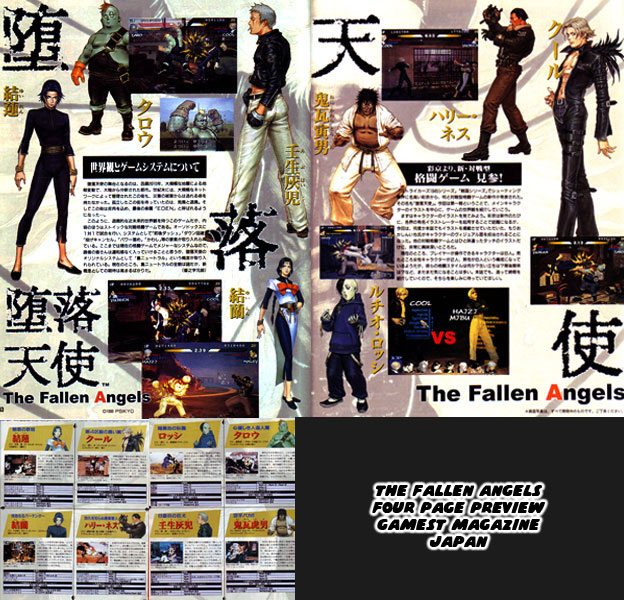
Psikyo had an uphill battle trying to get audiences behind their new game. Battle K-Road was such a poorly received fighter that most people assumed they were going to get more of the same. When it came to sprite-based titles audiences thought that the peak had already been reached. Capcom released Warzard two years earlier and Street Fighter III a year before The Fallen Angels. Fans were skeptical that Psikyo could match the size, and quality of the sprites in either game. Little did they know that there was always room to grow. The Fallen Angels and King of Fighters XII demonstrated that. Anyhow Psikyo went on a full press blitz for their title. They got Gamest, the top Japanese arcade magazine, to do a four-page special on The Fallen Angels. They wanted to show fans that their game was worth the wait. It started by breaking conventions. The majority of fighting games up until that point had martial artists in some sort of tournament. This game had no tournament, the fights were al interconnected through a story. This game had a couple of martial artists but they weren’t the traditional heroes that we had seen previously. Take the karate master in The Fallen Angels for example. Torao Onigawara was the hardest hitting karate fighter the world had ever seen. Yet his extreme dedication to his craft turned him into a literal demon. Well, a homeless demon.
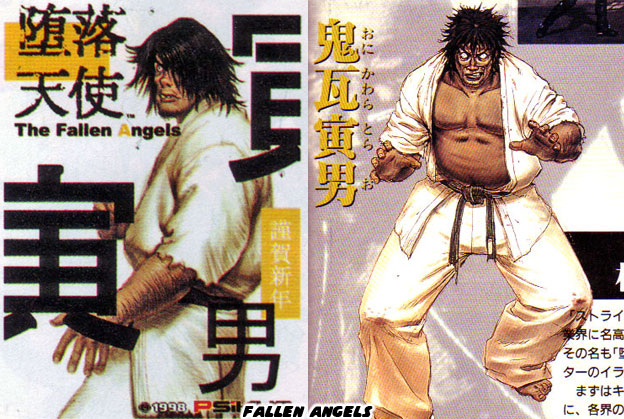
The romantic ideal of the karate fighter, somebody like Ryu for example, is flawed. Ryu was based on people like Mas Oyama and Yoshiji Soeno. People that became heroes by defeating other martial artists. In order to become great karate masters they lived like hermits. They trained in the mountains, under extreme weather conditions, isolated from human contact. They did pretty much nothing else for years. This made them mentally and physically stronger than their opponents. It turned them into legends. Then you take that idea to the extreme with a character like Torao. His zealotry showed in his design. His gi was worn and tattered, like Ryu’s, but unlike Ryu it was also dirty and covered in sweat stains. Torao in the game had literally stepped on screen after a training session. He had long, oily unwashed hair. The character looked like he hadn’t bathed in months. Steel Hearts actually animated Torao with tiny flies buzzing around his head. Other studios presented their characters in an ideal light, Psikyo went the opposite way. Ryu was always illustrated as young and handsome, even if a little bit rugged. Torao was raw, with a wild look in his eyes by comparison. Steel Hearts painted him with flies-a-buzzing and a snaggletooth sticking out from under his lip in the official character art. Even the name Onigawara was a play on words. An oni-gawara, literally a demon tile, was a decoration on a Japanese roof. Torao was no Ryu, he was more accurate to what an insane karate demon would look like.
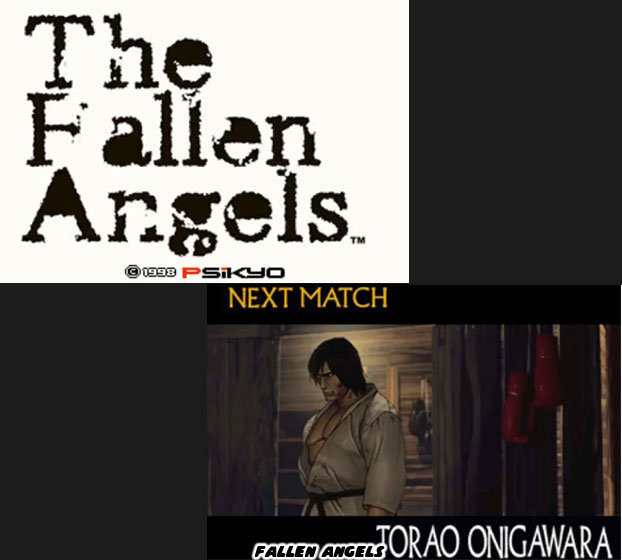
Every character in the game had an intense level of design and back story, not just Torao. Every character had a reason to fight and a reason to go through the lineup. Steel Hearts wanted players to feel as if they were living vicariously through the cast. The society that they were being brought into was on the verge of collapse. The stages were desolate, as if the last people on Earth were the main characters. It turned out that the fate of a tiny island nation rested in the hands of these people and an evil crime lord. Steel Hearts had reached a new level of directing for a fighting game. The situations that the cast found themselves in were serious. These weren’t some random fighters in a tournament, brought together by fate. Each encounter was a life or death struggle. I don’t think that any Japanese game since had matched the tone of The Fallen Angels. It was as if had been written and directed by Michael Mann, David Lynch or Brian De Palma. I’m certain that lead artist Morioka Shinichi, producer / co-designer Kouzou Fujimoto, and director / co-designer Mitsuo Kodama could turn this story into a compelling 6-episode OVA. Just look at the official story that played in the introduction.
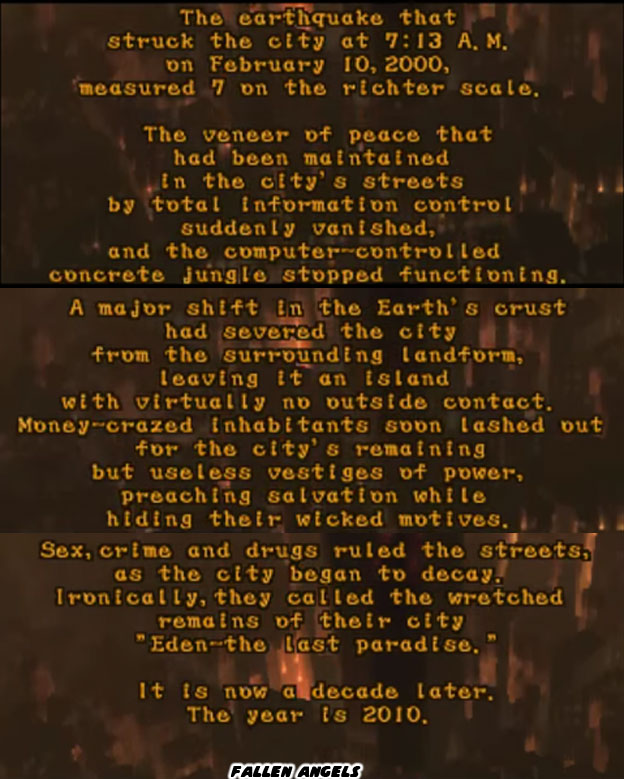
The world that Steel Hearts painted was very grim and brooding, more so than any standard metropolis. The island of Eden place never completely recovered from a massive earthquake. There was a reason why the inhabitants on the island were melancholy and hesitant to leave their homes. Drugs and crime had taken over the streets. Without direct access to state emergency resources they were at the mercy of local mob bosses. Also unlike other fighting games, even the gruesome ones like Mortal Kombat, the action here was grounded in realism. The characters did have some level of fantastic martial arts ability but they weren’t shooting fireballs or throwing burning dragon punches. They did actual take downs and slams, spinning backhand punches and thrusting axe kicks. We could imagine that these people were very real, or inspired by real heroes and villains. There was a dash of science fiction rather than fantasy in this world. Demons weren’t real in this game as they were in the Goketsuji Ichizoku / Power Instinct universe. Instead things like kidnapping, brainwashing, cloning were. To an extent even genetic modification was possible in this world. These sci-fi elements had been touched upon in the Tekken and Street Fighter universes. Yet none of the previous games had put the characters in such a foreboding world. No other game was ripe with an aura of depression. It was palpable. It hung over the stages. Over the cast, and over the intro screens.
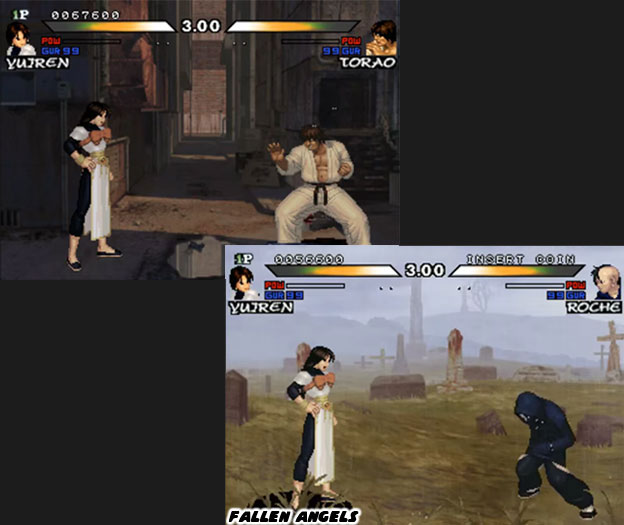
The streets were desolate in Eden. It made sense given the story leading up to the events in the title. Also since this wasn’t a game about a competition then it made sense that there weren’t bystanders cheering on the fighters. Sure it could be argued that the developers didn’t have enough time to create background characters but I do not think that was their intent all along. After spending years on an unfinished main cast they must have realized their resources weren’t being used to populate the city. This worked to their advantage. It made Eden look like a nice place to drive through but not stay. The team could focus on the cast, on the moves, on the fight mechanics. They could explore things that weren’t being done in other fighting games. For example, one of the things they created were custom win quotes for each character and rival. Having dedicated lines for every opponent helped create a relationship between characters. It helped sell the story and connect the reasons why everyone was fighting.
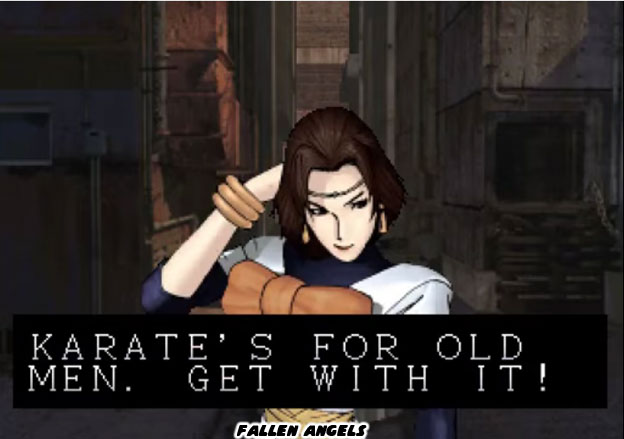
Every stage told a story, like the great fighting games before it. Eden had a literal atmosphere, including realistic fog and rain effects. The studio wanted Eden to look worn and lived in. The buildings and streets weren’t in the best condition. The fights didn’t happen in front of a flashy casino or sporting event. They happened in darkened rooftops and side alleys. They happened in seedy bars and open cemeteries. There was a sense of decay in these levels. This world was real and it was slowly falling apart. The years of neglect following the earthquake were showing. If something didn’t happen soon, and for the better then this world would fall apart completely. This was important to the story. All great stories happen at the critical moment, they don’t take place during the inconsequential periods. It was no different in this game. A crime boss named Carlos was consolidating his power. He was taking out his rivals with the help of some assassins, including a red-suit wearing gunman named Trigger. Carlos was making an already bleak existence in Eden even harder. Every character in the game had a vendetta against Carlos, if they weren’t secretly working for him. At least one person, a soldier named Harry Ness, was trying to bring him to justice in the mainland. But getting through Eden and back out alive would prove to be a challenge.
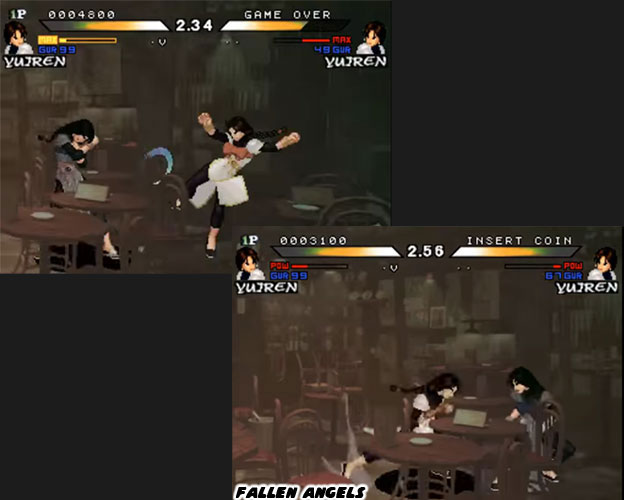
Steel Hearts took a number of unique approaches to the game. The final cast had eight playable characters. Like the original Street Fighter II. It also had a sub boss and boss. But like I said earlier, they were not the traditional martial arts masters. For example there were two female characters in the game, sisters named Yuiran and Yuiren. They ran a club called the Wind Fish. Yurien was a singer in the club and was actually a trans character. She was born the brother of Yurian, acting as protector and entertainment while her sister acted as a bouncer. Yurien had very fast strikes while her sister had the power moves. It was a unique change of traditional roles. This stage was an example of the sort of interactive environment that the studio wanted to build. There were chairs and tables in the foreground that obscured the view of audiences. This sort of blocking wasn’t done in other games. As players fought they could kick the chairs and tables over. It was a nice detail that was rarely used in other fighters. It helped make the fights look like they took place in an action film. The smoky club looked like it had been in business for a few generations and the sisters were doing everything they could to keep it going. The Wind Fish actually appeared twice in the game. The first time the club was intact, as if they had just closed for the night. By the end of the game Carlos and his goons had trashed the club. Whether he wanted the land, the clientele or the sisters out of business we might never know.
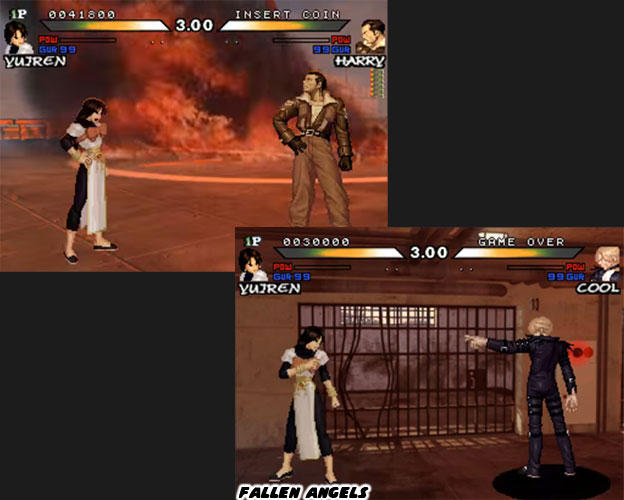
The Wind Fish was the only level to have foreground elements to knock over but again every stage told a story. Steel Hearts was experimenting with the format and trying to add details and effect rarely if ever used in other games. The chairs and tables were one example of expanding stage design. In other places they experimented with effects. Realistic fog and rain were one thing but the studio tried very hard to create a realistic flame effect on Harry’s stage. There was a massive fire on a helipad, as if Harry’s chopper had just crashed. Steel Hearts blended video effects onto the stage so that the raging inferno looked realistic because it was a real fire. The sprites the studio created also had a certain weight and depth to them. This was because not only were they carefully painted to display shadows and highlights, but because many of the idle and strike animations were rotoscoped. This was to say they were based on video of actual people performing the moves.
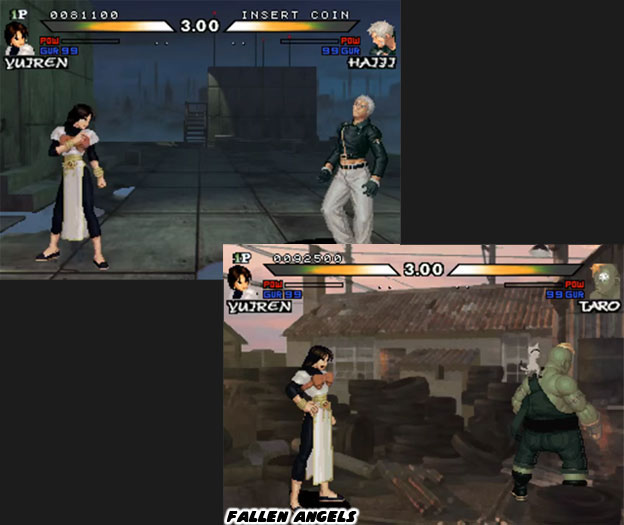
As the game progressed the encounters got more and more unique. The locations became more diverse and the opponents a little bit stranger. They were all leading up to a final showdown. Carlos had heard the rumors that there were fighters in Eden ready to take him down. So he pushed back with hitmen of his own. Some did it for the money, others did it because they were just evil. The final battles were unique. We will look at these in the next blog and see the legacy that the studio established. As always if you enjoyed this blog and would like to sponsor me please visit my Patreon page and consider donating each month, even as little as $1 would help make better blogs and even podcasts!

Hi Noe, great blog as usual.
ReplyDeleteJust a note: the links you put in the text are broken, they appear like this: https://www.blogger.com/“http://www.spoon-tamago.com/2017/02/22/oni-gawara-japanese-demon-roof-tiles-for-your-home/“ so we are forced to remove te part “https://www.blogger.com/“ in order to make them work.
Bye
Thanks Zero, I don't know why blogger would do that or for how long it has been doing that. Now I need to go backwards and see what it did.
Delete